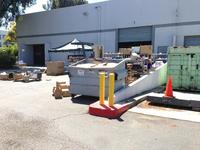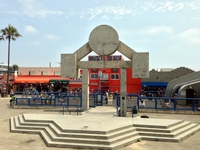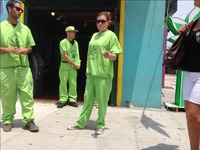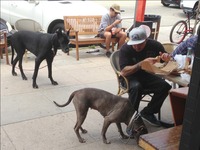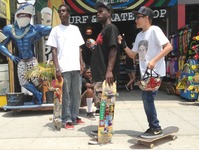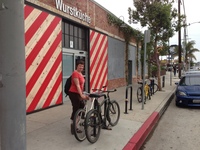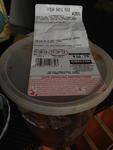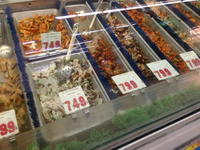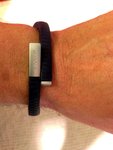 |
| Angelika/Mike Schilli |
|
|
Angelika Twenty-four years ago, on October 17th, 1989, to be precise, a 6.9 earthquake rattled San Francisco, and caused severe damage to the Bay Bridge, which connects the cities San Francisco and Oakland. A part of the upper deck slammed down on the lower part, killing one driver while crossing the bridge. Shortly after the quake, it became evident that the bridge wouldn't withstand another blow and would need to be replaced urgently. And this was the beginning of the struggle for the new bridge: Discussed were various building cost and design issues, like should it be a suspension bridge or not, one or two decks again, or with foot and bicycle paths? What made matters worse was that the two cities, San Francisco and Oakland, had to agree on all issues. Both cities were run by big-headed mayors, Willie Brown in San Francisco, and Jerry Brown, now governor of California, then mayor of Oakland. It took forever to build, but finally, after 24 years of construction drama, on September 3rd, 2013, the new bridge was opened to the public.
Only the eastern span is new, which connects Oakland and Yerba Buena Island in the middle of the Bay. The western span, leading drivers over the waters again all the way to San Francisco, remained unchanged. The original bridge span dates back to the 1930ies, and to make sure it will withstand the next earthquake, it was retrofitted with new steel beams by the civil engineers in charge. The construction work on the new eastern span began in January 2002, which runs alongside the old bridge. In 2009 the drama continued: During routine checks, Engineers found cracks in one of the steel beams (Rundbrief 11/2009), which lead to heated discussions about whether the steel parts for the new span, which were manufactured in China, where a cheap product "Made in China". Shortly before the grand opening, however, it was discovered that the steel bolts for earthquake-proofing the bridge were showing cracks as well. Ironically, those weren't "Made in China", but "Made in USA". This lead to another round of discussions about whether the bridge could even be reopened with the defective bolts or if it was prudent to wait and replace them.
The consensus was, after all, that it would be more dangerous to drive over the old bridge during an earth quake, than over the new bridge with its defective bolts, even though repairing them would take months. As you can see, the project wasn't exactly inspiring confidence. What I found quite sad personally, was that because of this glitch, the grand opening celebrations, which had been planned for months in advance, were canceled entirely.
What was still missing at this point was connecting the old western span with the new eastern span. To accomplish this, the entire bridge was closed over the long Labor Day weekend for a total of five days. I found it quite miraculous that this shutdown didn't wreak total havoc on Bay Area traffic. After all, about 240,000 cars are crossing the bridge on a regular day.
Starting Wednesday, August 28th, 8 p.m., no vehicle was allowed on the bridge anymore, in either direction. Since I had been working in the East Bay on this legendary Wednesday, I crossed the old bridge around 6 p.m. for the last time. I have to admit, I got somewhat sentimental at the time. While I was zooming over the bridge, heavy construction vehicles were waiting at the curb. After five days of closure, in the early morning hours of Tuesday, the wait was over and police let the first driver onto the eastern span. Later that day, I also crossed, and the new bridge pillars were sparkling in the sun.
But the kicker is that now pedestriants and bicyclists have access to the new eastern span of the Bay Bridge. There's a new foot and bike path. Naturally, Michael and I had to check it out last weekend. The hike is quite strenuous, since the path stretches about 2 miles before it even reaches the bridge. All the way to the midpoint and back, we hiked more than eight miles that day. The path starts right across from the Ikea store in Emeryville, and leads through rather bleak industrial areas and over highway bridges onto the Bay Bridge. The parking lot guard apparently doesn't want you to park on Ikea premises if you intend to hike, but I claim that it's a killer opportunity for Ikea, and as a matter fact, after we were done hiking, we went into the store and bought some things, following the Ikea mantra: Well, we're here already, why not ... For what it's worth, there's another trail entrance at Maritime Street.
On the hike, we enjoyed great views on the Bay, San Francisco and the old bridge, which is about to be disassembled over the coming years. We were surprised to see so many people walking the trail: Parents pushing strollers, kids on scooters, bicycle riders, runners and walkers. At this time, the trail ends at Yerba Buena Island. That's why the locals nick-named it "the pier". The old bridge needs to go away before the foot and bike path can connect to Yerba Buena Island. But even then, the trail won't go all the way to San Francisco, but there's already a lobby for that.
The trail exists mainly because of the accomplishments of a dedicated individual: Alex Zuckermann of the East Bay Bike Coalition kept pushing for a bike-accessible Bay Bridge in political meetings for a large part of his life. Sadly, he died in 2007 at age 86 and didn't get to ride the new trail on his bike. But the foot and bike path is named after him and I bet he'd be thrilled to see how popular it is already.
Angelika We are Greencard holders, not American citizens, and therefore can't vote in the US. But German citizens residing in a foreign country are still eligable to vote in federal elections in Germany via absentee voting. The regulations require having lived at least 3 months in Germany without interruptions after having completed one's 14th birthday, and this can't be more than 25 years ago. Alternatively, a German citizen living abroad can make a case that they still have a pretty good grasp on what's going on in German politics, but the official flyer points out explicitely that it's not sufficient to claim to consume German media outlets abroad.
Well, it's been less than 25 years since we've moved here, and for that reason we voted via absentee ballot this year. I've mentioned here before that you can't simply get the election documents from the German consulate in San Francisco (Rundbrief 09/2002). According to the Election instructions for Germans living abroad we needed to send an application to be included in the election registry first. For this to happen, the absentee voter downloads a PDF document from the website referenced above. It requires entering one'e name, date of birth, passport number, and the current foreign address, as well as the address of the last residence in Germany, including the date of when the individual officially unregistered there.
We're so lucky that I always keep everything on archive! On top of that, we needed to assure that we're over 18 years of age and therefore eligable to vote, and that we meet the requirements listed above for absentee voting. We then mailed our applications to the electoral offices in the cities of our last residence, which was Munich in my case and for Michael the city of Augsburg. The deadline for election applications was September 2nd this year, permitting enough time for processing. We had our doubts that anyone over there would actually take our applications seriously, but apparently German public servants are still reliable as clockworks, because after a couple of weeks, we received correctly stamped and addressed envelopes with the requested electoral sheets!
We then used a ball pen to cast our vote, and placed the paper ballots into the provided envelopes. The ballots go into an anonymous sealed envelope, which then goes into the return envelope. This turned out to be difficult with the ballot envelope provided by the city of Augsburg, which was excactly the size of the return envelope! The electoral office in Munich had put more thought into it, with a slightly smaller ballot envelope that fit perfectly into the return envelope.
Correctly stamped ($1.10), we sent the envelopes back across the big sea. Hopefully, they arrived there in good shape. We've read in "Spiegel" magazine that many German citizens refrain from voting these days and it's considered to be socially acceptible. I hope you're not one of these people, go to the voting booth, every vote counts!
Michael Until a few years ago, Americans didn't care much about saving the environment or recycling, but nowadays it's extremly hip to be "green". In previous editions of this newsletter, we've explained how to correctly dispose of old TV sets (Rundbrief 12/2010) or to separate garbage into the different bins provided in San Francisco (Rundbrief 02/2006).
If you want to get rid of old computer parts in Silicon Valley, there's a nondescript store called Weirdstuff at address 384 West Caribbean Drive in Sunnyvale in a warehouse neighborhood, just around the corner from Yahoo headquarters. At the back entrance, there's a drop-off where workers collect donated components, and the store in front has usable parts nicely sorted on long shelves for sale for little money.
It's no secret that I like to to tinker with all kinds of components and assemble them to create new inventions. If I bought the parts at a regular computer store, it'd cost me an arm and a leg. Often times, used parts are perfect for the job, and I can get them cheaply at Weirdstuff during my lunch break. And the staff is easy-going there, I've had items with no price tag on them at the register, and the cashier just asked "Two bucks okay?" to which I replied "Sure!", handing over two dollars plus tax ($2.18). Good deal, for a new part I would have had to pay $10 easily.
Damaged goods donated in the back Weirdstuff apparently passes on to a Recycling Center, where old monitors are taken apart and old circuit boards are being chopped up for proper disposal. Functioning components, on the other hand, are offered for sale in the front store. The Weirdstuff guys apparently are operating cost-effectively, their business seems to be going well and whenever I'm there, there's always some customers rummaging through the bargain bins. A win-win situtation for everyone!
Angelika Living in a densely populated metropolitan area often requires a lot of patience to get you through the day. Whenever you have a lot of people in a crowded space, there seem to always be a small number of inconsiderate idiots who think they own the place. Apparently, I'm not the only one thinking this way, as the local Kron 4 station here keeps airing a segment called "People Behaving Badly" during the daily 8 PM newscast.
Stanley Roberts is the reporter scouting San Francisco and the surrounding area with his camera man for people who have little respect for local laws or the rules of common courtesy. Often times, he targets conspicuous drivers in Bay Area traffic, like people who take the liberty to illegally park at bus stops or make left turns, although they're well aware that that's not permitted at a particular intersection.
Many quickly send a text message while waiting at a stop light, although that's been illegal in California for quite a while now. That's also a pet peeve of mine that makes my blood pressure go up, as those distracted drivers often don't notice when the light goes green or suddenly accelerate while it's still red.
Another popular topic are dog owners, who don't put their dogs on leash although the signs in conservation areas clearly demand so. The other day, there was a segment on drivers on the new Bay Bridge, who clearly used poor judgement when taking videos with one hand while crossing at a speed of about 55 miles per hour. Some of them even had passengers, which makes you wonder what goes on in people's heads at times. The reporter often teams up with local police, and the camera team then follows them around when officers are writing tickets and hear breathtaking excuses.
Stanley Roberts exclusively targets people who do things that are clearly illegal, but no American finds overly offensive, according to unwritten California laws. But behind closed doors, it seems that people do take issue after all, which makes "People Behaving Badly" such a success, because Stanley Roberts seems to be the only righteous person who points out the culprits.
Michael Residents of San Francisco and the surrounding Bay Area fancy cultivating a long tradition of absolutely hating everything about Los Angeles. Except we don't subscribe to such prejudice and travel down there every once in a while. Also, when Americans say "Los Angeles", they actually don't mean the downtown district, but an eclectic conglomerate of suburbs forming a gigantic metropolitan area home to some 20 million people. Every single one of these neighborhoods is completely different and no person with integrity would lump them all together and rate them as a whole.
For instance, we really enjoy staying in Venice. You might have heard of "Muscle Beach", where the early Arnold Schwarzenegger kept toning his body at the outdoor gym on the beach way back when in the eighties. Nowadays, hardly anyone is pushing weights there anymore, but we rented bicycles and rode along the beach almost all the way up to Malibu. In Figure 16 you can admire Angelika on her beach cruiser, which is similar to a dutch bike with an extra wide saddle and a comfortably mounted handle bar for cruising along the board walk at the beach. They charged a whopping $20 per day for it! Just to compare: Rental cars in the Los Angeles area are about the same price. By the way, check out the basket in front of Angelika's cruiser in Figure 16, you can see a backpack with a rather unassuming "Y!" logo. Don't tell anyone, but that's the secret giveaway of someone working at Yahoo. Recently, someone approached us in an elevator in Las Vegas because of it.
The Venice boardwalk displays an interesting mix of tourists, stranded runaways, dubious characters, and homeless people. In winter, the area is pretty much dead, but during the summer months the hustle and bustle until late at night is quite appealing. On the beach, every Joe Schmoe owning a drum can join the Drummers of Venice Beach and hammer away for hours to hot rhythms. Booth dealers sell all kinds of nicknacks, from henna tattooes to painted skulls. The stores along the boardwalk also offer a broad array of merchandize, from tourist shops selling t-shirts with tintillating imprints, to tattoo parlors, or doctors who write marihuana prescriptions for $40, to hash pipe supply shops.
The area isn't exactly squeaky clean, and LAPD, known for not being timid, is always present to step in every once in a while when a crazy person causes a disturbance, but violent outbreaks are rare. Apparently, there's been muggings in the dark alleys near the boardwalk, but we've never ever encountered anything of concern. Sure, every once in a while, you have to step over a crazy homeless man who thinks it's a good idea to lay down flat in the middle of the sidewalk, or some lunatic starts screaming for no apparent reason, but we're somewhat used to that level of crazyness from living in San Francisco for almost 20 years.
Then there's the posh neighborhood of Venice that instilled its name: The district with those small canals that are supposed to look like the waterways in Venice/Italy. Unfortunately, you'll only find vacation homes of the super rich there, which are vacant most of the time, which contributes to the ghost town appeal of the neighborhood, although the houses are built in style and show tasteful interior design as well.
What's really great about Los Angeles is its variety of absolutely top notch restaurants. Although the streets aren't super clean, even the smallest hole in the wall eatery is subject to regularly recurring checks by the health department to make absolutely sure that food preparation and serving comply with an astonishingly strict code. On top of that, every restaurant has to display the grade ("A" through "C") obtained during the latest inspection boldly in its front window (Rundbrief 03/2009). I've never seen a grade other than "A", though, I presume no self-respecting resident of L.A. would enter premises rated lower.
And the food creations are indeed nothing short of spectacular. Especially in the sushi category, you have to know: Sushi restaurants in the Bay Area around San Francisco are about ten times better on average than their counterparts in Germany. What's sold as sushi in Germany wouldn't even pass the quality requirements for dog food over here! Then, if you drive down to Los Angeles, you'll be surprised to find out that the sushi creations down there are again ten times better than in the Bay Area. German tourists would inevitably sustain a permanent sushi shock! If you think now "Oh god, now the old miser has completely lost it, my super expensive Japanese restaurant in Munich serves excellent sushi", then I recommend you watch the documentary "Jiro -- Dreams of Sushi" and learn that serving world class sushi requires much more than just slicing fresh fish (which you can't even get in Munich). You read it here first.
This amazing multitude of dining options creates a fierce competition between the restaurants, resulting in highly critical patrons who will start complaining immediately if dishes that are not 100% satisfactory. That's a great incentive even for the smallest establishment to excel, because if they don't, it doesn't take long until the word gets around on sites like Yelp and they'll be forced to shut down because of slowing business.
No doubt international cuisine is equally top-notch in such a melting pot of nations. Whether it's the tiny sandwich deli around the corner or the spanish bodega in a small alley, or a German-infused sausage heaven named "Wurstküche", where the barman pours a microbrew named "Zwickl" imported from the German city of Bayreuth: There's always something special about a place to distinguish themselves from the rest of the pack.
Angelika We discovered the Hawaiian dish "Poke" (pronounced "po-kah") on one of our trips to the islands and since we're both really into raw fish and Japanese cuisine, it really hit it off with our taste buds. It's a very traditional and common fish preparation technique on Hawaii, where you can buy it at any supermarket's Poke counter, similar to cheese or meat counters in Germany.
Poke means "cut into small pieces", and the traditional preparation is cubed raw tuna, with added sauces and spices, like soy sauce, sesame oil, sea salt or Hawaiian sea weed (limu). In some variations, the connoisseur finds the mild and almost sweet tasting Maui onions, or garlic. And there's even Poke made from other types of fish, like octopus ("tako poke").
Whenever we're on Hawaii, we eat Poke almost every day, and when we're back in San Francicso, we miss having it. But Michael discovered the other day, that his beloved Costco supermarket in San Francisco actually started selling freshly made Poke. Not in as many variations as on Hawaii, but it's a start. We started having Poke on the weekends here now every now and then, it's delicious!
Michael Sitting in the office all day is not healthy. Actively moving around is good for you and helps avoiding putting on those otherwise inevitable pounds around the waistline. But how many steps are you actually walking during the day, is it sufficient by the time you come home or should you run for half an hour on the tread mill or go for a late evening walk around the block on top of that? To find out about that, I've been wearing the bracelet in Figure 27 since beginning of August.
The so-called Up Band by a company named Jawbone tracks how many steps I'm going per day and how many hours of sleep I get during the night. On my smartphone, I can then look at colorful graphics and check how many calories I've burned, how long I've been sitting around inactively and how many times I woke up during the night. What's more, I can program the band to wake me up with a gently vibration when it's about time, but not when I'm deeply asleep, only when I'm already nervously moving in bed. Allegedly, waking up is less brutal this way.
Since Angelika is wearing a band herself, feeds the collected data into her smartphone, and chose to share it with me, I can now follow along with her sportive activities and make sarcastic comments if her step counter shows less than the recommended 10,000 steps at the end of the day. You can configure different goals if you like. If there's more people in your "team", this tends to spur competition and daily new records, because everyone wants to outperform the rest of the pack. At work at Yahoo, my colleagues actually started to rack up miles in the morning on training runs or hiked many miles on the weekends to temporarily take the lead in the group.
The Up Band simply tracks acceleration data while you're swinging your arms during walking or running activities. It won't notice whether you're actually moving and because of that it works just as well on a stepper or treadmill. It guesses the covered distance more or less accurately and if it's too far off, you can recalibrate it with manually entered data from an external GPS tracker like the one built into your smartphone. Of course, you could easily trick the device by attaching it to a crawling toddler or a pet, but that would be cheating!
The new-fangled gadget is not exactly cheap at a price of $130, and if you have bad luck, it stops working after a while, as seen with some of my colleagues at work. But that's the price for chasing the latest fashion trends and being the first to try out new gadgets. And I can confirm that the band does turn heads and is a great conversation starter, it's very common that random people inquire about it. Top product!
Greetings from Europe's future:
Angelika & Michael













